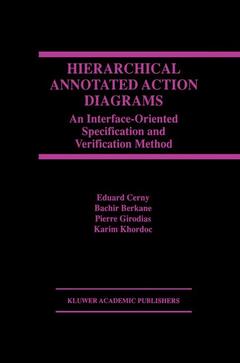Description
Hierarchical Annotated Action Diagrams, Softcover reprint of the original 1st ed. 1998
An Interface-Oriented Specification and Verification Method
Authors: Cerny Eduard, Berkane Bachir, Girodias Pierre, Khordoc Karim
Language: English
Subjects for Hierarchical Annotated Action Diagrams:
105.49 €
In Print (Delivery period: 15 days).
Add to cart
Publication date: 10-2012
211 p. · 15.5x23.5 cm · Paperback
211 p. · 15.5x23.5 cm · Paperback
Description
/li>Contents
/li>
Standardization of hardware description languages and the availability of synthesis tools has brought about a remarkable increase in the productivity of hardware designers. Yet design verification methods and tools lag behind and have difficulty in dealing with the increasing design complexity. This may get worse because more complex systems are now constructed by (re)using Intellectual Property blocks developed by third parties. To verify such designs, abstract models of the blocks and the system must be developed, with separate concerns, such as interface communication, functionality, and timing, that can be verified in an almost independent fashion. Standard Hardware Description Languages such as VHDL and Verilog are inspired by procedural `imperative' programming languages in which function and timing are inherently intertwined in the statements of the language. Furthermore, they are not conceived to state the intent of the design in a simple declarative way that contains provisions for design choices, for stating assumptions on the environment, and for indicating uncertainty in system timing.
Hierarchical Annotated Action Diagrams: An Interface-OrientedSpecification and Verification Method presents a description methodology that was inspired by Timing Diagrams and Process Algebras, the so-called Hierarchical Annotated Diagrams. It is suitable for specifying systems with complex interface behaviors that govern the global system behavior. A HADD specification can be converted into a behavioral real-time model in VHDL and used to verify the surrounding logic, such as interface transducers. Also, function can be conservatively abstracted away and the interactions between interconnected devices can be verified using Constraint Logic Programming based on Relational Interval Arithmetic.
Hierarchical Annotated Action Diagrams: An Interface-OrientedSpecification and Verification Method is ofinterest to readers who are involved in defining methods and tools for system-level design specification and verification. The techniques for interface compatibility verification can be used by practicing designers, without any more sophisticated tool than a calculator.
Hierarchical Annotated Action Diagrams: An Interface-OrientedSpecification and Verification Method presents a description methodology that was inspired by Timing Diagrams and Process Algebras, the so-called Hierarchical Annotated Diagrams. It is suitable for specifying systems with complex interface behaviors that govern the global system behavior. A HADD specification can be converted into a behavioral real-time model in VHDL and used to verify the surrounding logic, such as interface transducers. Also, function can be conservatively abstracted away and the interactions between interconnected devices can be verified using Constraint Logic Programming based on Relational Interval Arithmetic.
Hierarchical Annotated Action Diagrams: An Interface-OrientedSpecification and Verification Method is ofinterest to readers who are involved in defining methods and tools for system-level design specification and verification. The techniques for interface compatibility verification can be used by practicing designers, without any more sophisticated tool than a calculator.
1 Introduction.- 1.1 Digital System Design and Verification.- 1.2 Interface-Oriented Models.- 1.3 Purpose and Organization of the Book.- 2 Overview of HAAD Method.- 2.1 Leaf Action Diagrams.- 2.2 Annotations in Leaf Action Diagrams.- 2.3 Hierarchical Action Diagrams.- 2.4 Annotations in HAAD Hierarchy.- 3 Formal Characterization of HAAD.- 3.1 Leaf-Level Action Diagram Algebra.- 3.2 Verification.- 3.3 Language of Hierarchical Action Diagrams.- 3.4 Related work.- 4 HAAD VHDL Model.- 4.1 Execution of HAAD VHDL Models.- 4.2 Execution of Hierarchical Action Diagrams.- 4.3 Occurrence Time Enumeration of Output Actions.- 4.4 Enumeration and Delay Correlation.- 4.5 Organization of a HAAD Model in VHDL.- 5 Consistency, Causality and Compatibility.- 5.1 Introduction.- 5.2 Basic Concepts.- 5.3 Problems.- 5.4 BlockMachines.- 5.5 Derived Block Machines.- 5.6 Causal Action Diagrams.- 5.7 Compatibility of Action Diagrams.- 5.8 Conclusions.- 6 Interface Verification using CLP.- 6.1 Interface Timing Verification.- 6.2 Constraint Logic Programming.- 6.3 The Event Separation Problem.- 6.4 Delay Correlation.- 6.5 CSP and CLP Based on RIA.- 6.6 Solving ITV with CLP Based on RIA.- 6.7 Examples.- 6.8 Experimental Results.- 6.9 Concluding Remarks.- 7 Example: Interfacing ARM7 and a Static RAM.- 7.1 Problem Definition.- 7.2 Bus Functional Model of ARM7 Subset.- 7.3 Bus Functional Model of RAM.- 7.4 VHDL Model of interface transducer.- 7.5 Putting it all together.- 7.6 Static Interface Timing Verification.- 8 Summary and Recent Developments.- 8.1 Summary.- 8.2 Recent Developments.- 8.3 Future Directions.- References.- A Grammar of the HAAD Language.- A.1 Conventions.- A.2 Semantic Notes.- A.2.1 Generics.- A.2.2 Name Spaces.- A.2.3 Default Constraint Bounds.- A.3 Grammar Definition.- B Proofs forChapter.- B.1 Proof of Theorem 3.1.- B.2 Proof of Theorem 3.2, 3.3, 3.4, and 3.5.- B.3 Proof of Theorem 3.6.- B.4 Proof of Theorem 3.7.- B.5 Proof of Theorem 8.- B.6 Proof of Theorem 3.9.- B.7 Proof of Theorem 3.10.
© 2024 LAVOISIER S.A.S.




